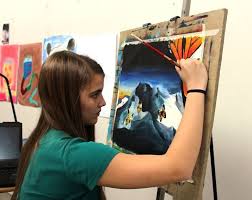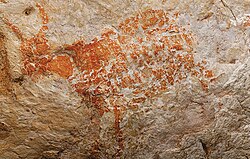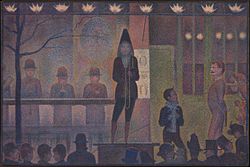Market List
Painting
Rashmi
Rashmi
QLD AEROGLEN da CVB
Painting is a visual art, which is characterized by the practice of applying paint, pigment, color or other medium to a solid surface (called "matrix"[1] or "support").[2] The medium is commonly applied to the base with a brush, but other implements, such as knives, sponges, and airbrushes, may be used. One who produces paintings is called a painter.
In art, the term "painting" describes both the act and the result of the action (the final work is called "a painting"). The support for paintings includes such surfaces as walls, paper, canvas, wood, glass, lacquer, pottery, leaf, copper and concrete, and the painting may incorporate multiple other materials, including sand, clay, paper, plaster, gold leaf, and even whole objects.
Painting is an important form of visual art, bringing in elements such as drawing, composition, gesture, narration, and abstraction.[3] Paintings can be naturalistic and representational (as in still life and landscape painting), photographic, abstract, narrative, symbolistic (as in Symbolist art), emotive (as in Expressionism) or political in nature (as in Artivism).
A portion of the history of painting in both Eastern and Western art is dominated by religious art. Examples of this kind of painting range from artwork depicting mythological figures on pottery, to Biblical scenes on the Sistine Chapel ceiling, to scenes from the life of Buddha (or other images of Eastern religious origin).
History
[edit]
Main article: History of painting
Cave paintings depicting a wild boar hunt in the Maros-Pangkep karst of Sulawesi are estimated to be at least 43,900 years old (2014). This finding was recognized as "the oldest known depiction of storytelling and the earliest instance of figurative art in human history.”
Redrawing of hunting scene from the Caves in the Maros-Pangkep karst
The depiction of a bull found in the Lubang Jeriji Saleh, Indonesia, in 2018, is the world’s oldest known figurative painting. The painting is estimated to have been created around 40,000 to 52,000 years ago, or even earlier.
The oldest known are more than 40,000-60,000 years old (art of the Upper Paleolithic) and found in the caves in the district of Maros (Sulawesi, Indonesia). The oldest are often constructed from hand stencils and simple geometric shapes.[4][a]
In 2021, researchers discovered ancient cave art in Leang Tedongnge, Sulawesi, Indonesia, estimated to be at least 45,500 years old. Depicting a warty pig, this artwork is recognized as the world’s oldest known example of figurative or representational art.
In November 2018, scientists reported the discovery of the then-oldest known figurative art painting, over 40,000 (perhaps as old as 52,000) years old, of an unknown animal, in the cave of Lubang Jeriji Saléh on the Indonesian island of Borneo.[6][7] In December 2019, cave paintings portraying pig hunting within the Maros-Pangkep karst region in Sulawesi were discovered to be even older, with an estimated age of at least 43,900 years. This finding was recognized as "the oldest known depiction of storytelling and the earliest instance of figurative art in human history."[8][9] In 2021, cave art of a pig found in Sulawesi, Indonesia, and dated to over 45,500 years ago, has been reported.[10][11] On July 3, 2024, the journal Nature published research findings indicating that the cave paintings which depict anthropomorphic figures interacting with a pig and measure 36 by 15 inches (91 by 38 cm) in Leang Karampuang are approximately 51,200 years old, establishing them as the oldest known paintings in the world.[12][13]
There are examples of cave paintings all over the world—in Indonesia, France, Spain, Portugal, Italy, China, India, Australia, Mexico,[14] etc. In Western cultures, oil painting and watercolor painting have rich and complex traditions in style and subject matter. In the East, ink and color ink historically predominated the choice of media, with equally rich and complex traditions.
The invention of photography had a major impact on painting. In the decades after the first photograph was produced in 1829, photographic processes improved and became more widely practiced, depriving painting of much of its historic purpose to provide an accurate record of the observable world. A series of art movements in the late 19th and early 20th centuries—notably Impressionism, Post-Impressionism, Fauvism, Expressionism, Cubism, and Dadaism—challenged the Renaissance view of the world. Eastern and African painting, however, continued a long history of stylization and did not undergo an equivalent transformation at the same time.[citation needed]
Modern and Contemporary art has moved away from the historic value of craft and documentation in favour of concept. This has not deterred the majority of living painters from continuing to practice painting either as a whole or part of their work. The vitality and versatility of painting in the 21st century defy the previous "declarations" of its demise. In an epoch characterized by the idea of pluralism, there is no consensus as to a representative style of the age. Artists continue to make important works of art in a wide variety of styles and aesthetic temperaments—their merits are left to the public and the marketplace to judge.
The Feminist art movement[15] began in the 1960s during the second wave of feminism. The movement sought to gain equal rights and equal opportunities for female artists internationally.
Elements of painting
[edit]
Chen Hongshou (1598–1652), Leaf album painting (Ming dynasty)
Georges Seurat, Circus Sideshow (French: Parade de cirque) (1887–88)
Color and tone
[edit]
Color, made up of hue, saturation, and value, dispersed over a surface is the essence of painting, just as pitch and rhythm are the essence of music. Color is highly subjective, but has observable psychological effects, although these can differ from one culture to the next. Black is associated with mourning in the West, but in the East, white is. Some painters, theoreticians, writers, and scientists, including Goethe,[16] Kandinsky,[17] and Newton,[18] have written their own color theory.
Moreover, the use of language is only an abstraction of color equivalent. The word "red", for example, can cover a wide range of variations from the pure red of the visible spectrum of light. There is not a formalized register of different colors in the way that there is agreement on different notes in music, such as F or C♯. For a painter, color is not simply divided into basic (primary) and derived (complementary or mixed) colors (like red, blue, green, brown, etc.).
Painters deal practically with pigments,[19] so "blue" for a painter can be any of the blues: phthalocyanine blue, Prussian blue, indigo, Cobalt blue, ultramarine, and so on. Psychological and symbolical meanings of color are not, strictly speaking, means of painting. Colors only add to the potential, derived context of meanings, and because of this, the perception of a painting is highly subjective. The analogy with music is quite clear—sound in music (like a C note) is analogous to "light" in painting, "shades" to dynamics, and "coloration" is to painting as the specific timbre of musical instruments is to music. These elements do not necessarily form a melody (in music) of themselves; rather, they can add different contexts to it.







